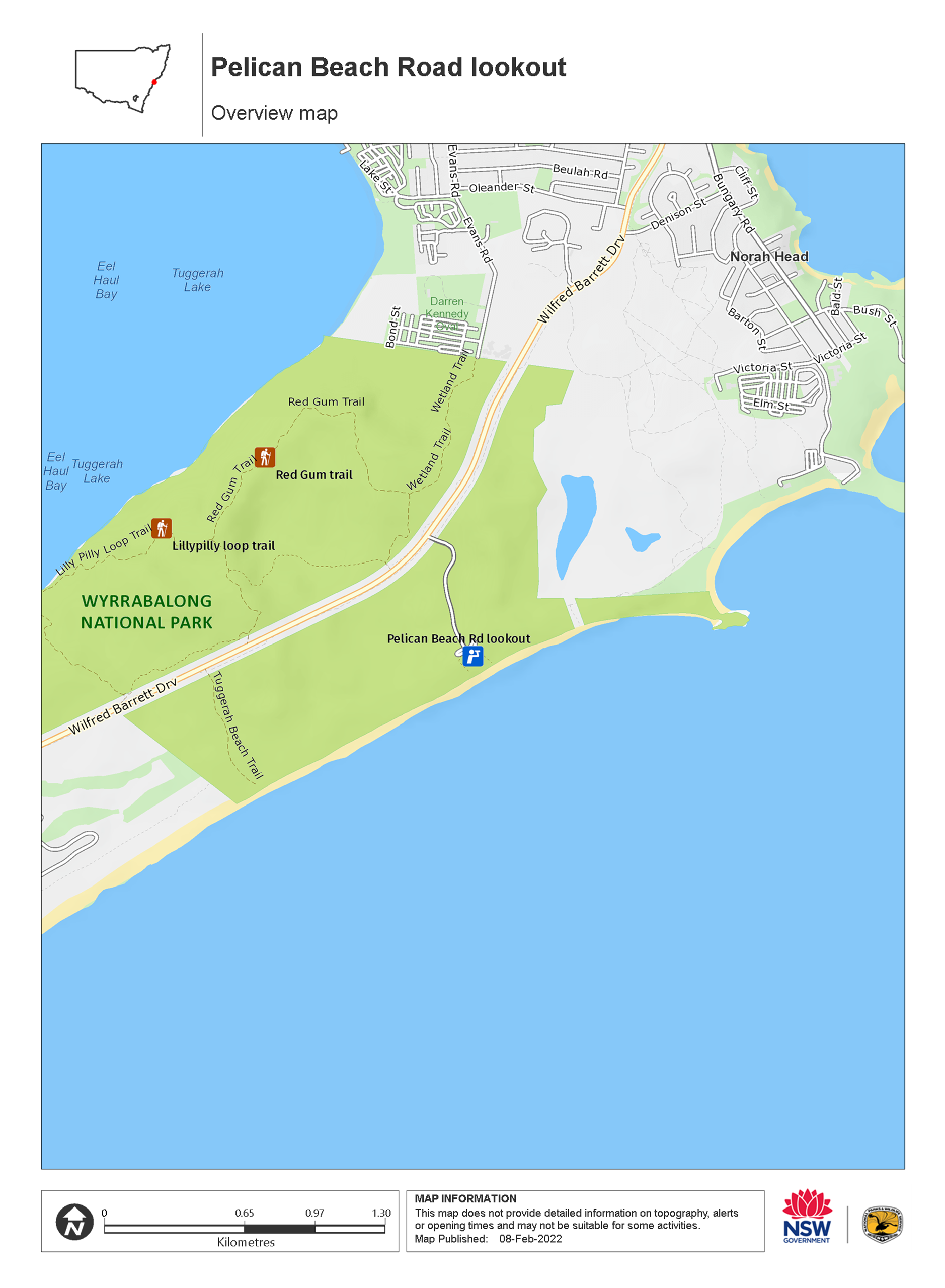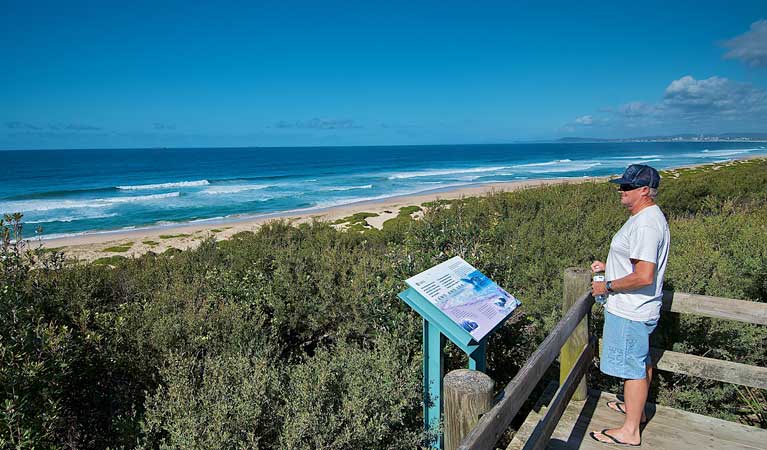Pelican Beach Road lookout
Wyrrabalong National Park
Overview
Pelican Beach Road lookout offers scenic views over The Entrance and Pelican Beach and is a great spot for whale watching. The beach is popular for fishing and surfing.
- Type
- Lookouts
- What to
bring - Drinking water, hat, sunscreen
- Please note
- Remember to take your binoculars if you want to whale watch
Take in the golden sands and sapphire waters of Pelican Beach from Pelican Beach Road lookout. Look to the north to see Pelican Point, a picturesque hotspot for beach fishing, or turn your gaze southwards for views of The Entrance.
As well as offering scenic views, the lookout also comes in handy for local surfers keen to check out the waves and those interested in whale watching. Once you’ve finished enjoying the view, why not put yourself in the picture and capture a photo.
On a sunny day, take a walk along Pelican Beach, dipping your toes in the water and looking for shells along the way. Nearby bushwalks include Red gum trail and Lillypilly loop trail.
Map

Map legend

Local alerts
For the latest updates on fires, closures and other alerts in this area, see https://www.nationalparks.nsw.gov.au/things-to-do/lookouts/pelican-beach-road-lookout/local-alerts
General enquiries
- National Parks Contact Centre
- 7am to 7pm daily
- 1300 072 757 (13000 PARKS) for the cost of a local call within Australia excluding mobiles
- parks.info@environment.nsw.gov.au
Park info
- in Wyrrabalong National Park in the Sydney and surrounds region
Wyrrabalong National Park is open from 5.30am to 8pm during daylight saving and 5.30am to 6pm rest of year.
Visitor info
All the practical information you need to know about Pelican Beach Road lookout.
Getting there and parking
Pelican Beach Road lookout is in the northern section of Wyrrabalong National Park.
To get there:
- Travel north along Wilfred Barnett Drive from The Entrance
- After about 8km, turn right into Pelican Beach Road and follow it to the end.
Road quality
- Sealed roads
Vehicle access
- 2WD vehicles
Weather restrictions
- All weather
Parking
Parking is available at the Pelican Beach carpark, a short walk from the lookout.
Best times to visit
There are lots of great things waiting for you in Wyrrabalong National Park. Here are some of the highlights.
Spring
A spring visit allows you to see gorgeous wildflower displays as you walk through the park.
Summer
It's summertime and the water's great – visit to surf, swim or snorkel in the park's superb beaches and it's a great time of year to fish for prawns and blue swimmer crabs at Tuggerah Lake.
Winter
Head to Wyrrabalong or Crackneck lookouts – these high headlands are perfect posts for watching whales on their northern migration.
Weather, temperature and rainfall
Summer temperature
Average
20°C and 25°C
Highest recorded
42.4°C
Winter temperature
Average
10°C and 17°C
Lowest recorded
3.4°C
Rainfall
Wettest month
February
Driest month
August
The area’s highest recorded rainfall in one day
246mm
Facilities
Picnic tables
Carpark
Maps and downloads
Permitted
Fishing
A current NSW recreational fishing licence is required when fishing in all waters.
Prohibited
Pets
Pets and domestic animals (other than certified assistance animals) are not permitted. Find out which regional parks allow dog walking and see the pets in parks policy for more information.
Smoking
NSW national parks are no smoking areas.
Learn more
Pelican Beach Road lookout is in Wyrrabalong National Park. Here are just some of the reasons why this park is special:
Aboriginal culture

North Wyrrabalong forms part of traditional Country of the Awabakal People, with south Wyrrabalong (cut off from the north by The Entrance channel) being Darkinjung Country. The park has a rich Aboriginal history and protects many significant cultural sites, including an extensive midden at Pelican Point. You can take a guided tour with Nyanga Walang to find out more about local Darkinjung history.
- Wyrrabalong Aboriginal cultural tour Walk alongside an Aboriginal guide in Wyrrabalong National Park and learn about the plants, animals and landscape while listening to cultural stories.
Red gum forest

The northern section of Wyrrabalong National Park protects the largest stand of Sydney red gums, or Angophoras, on the Central Coast. Explore the red gum forest and enjoy the shade of these magnificent native trees along the Red Gum trail in north Wyrrabalong. See how the forest changes depending on the season – trunks change from orange in summer to pinkish-grey in winter. Visit around December to see the trees adorned with white flowers, and spot honeyeaters in the branches in wintertime. The park is also an important haven for a variety of wildlife, including a number of threatened migratory birds that visit the coastal strip between Forresters Beach and Blue Lagoon in the park’s southern section. There’s even a population of marine turtles in Tuggerah Lake – if you’re lucky, you might see a loggerhead turtle; they have a large head in proportion to the rest of its body.
- Junior ranger: Whale tales at Wyrrabalong Hey junior whale watchers! These school holidays have fun whale watching at Crackneck Point lookout in Wyrrabalong National Park, near The Entrance. Learn how to spot whales on their annual migration.
- Lillypilly loop trail The easy Lillypilly loop trail is a lovely rainforest walk on the NSW Central Coast. Enjoy birdwatching and scenic views over Tuggerah Lakes.
- Pelican Beach Road lookout Pelican Beach Road lookout offers scenic views over The Entrance and Pelican Beach and is a great spot for whale watching. The beach is popular for fishing and surfing.
- Wyrrabalong Aboriginal cultural tour Walk alongside an Aboriginal guide in Wyrrabalong National Park and learn about the plants, animals and landscape while listening to cultural stories.
Whale watching

The park's spectacular coastal lookouts - both north and south - are ideal vantage points for whale watchers. Bring your binoculars to Crackneck Point lookout in whale watching season and prepare to be astounded. Whales are frequently seen breaching and tail-slapping nearby. And watch for the blow as they surface for air - there's really nothing like it.
- Tandem paragliding on the NSW Central Coast Take a tandem flight with Cloudbase Paragliding and be treated to a stunning bird’s eye view of Wyrrabalong National Park on the NSW Central Coast.
Plants and animals protected in this park
Animals
-

Australian pelican (Pelecanus conspicillatus)
The curious pelican is Australia’s largest flying bird and has the longest bill of any bird in the world. These Australian birds are found throughout Australian waterways and the pelican uses its throat pouch to trawl for fish. Pelicans breed all year round, congregating in large colonies on secluded beaches and islands.
-

Brown-striped frog (Lymnastes peronii)
One of the most common frogs found in Australia, the ground-dwelling brown-striped frog lives in ponds, dams and swamps along the east coast. Also known as the striped marsh frog, this amphibian grows to 6.5cm across and has a distinctive ‘tok’ call that can be heard all year round.
Plants
-

Cabbage palm (Livistona australis)
With glossy green leaves spanning 3-4m in length and a trunk reaching a height of up to 30m, the cabbage tree palm, or fan palm, is one of the tallest Australian native plants. Thriving in rainforest margins along the east coast of NSW, in summer this giant palm produces striking spikes of cream flowers which resemble cabbages.
-

Old man banksia (Banksia serrata)
Hardy Australian native plants, old man banksias can be found along the coast, and in the dry sclerophyll forests and sandstone mountain ranges of NSW. With roughened bark and gnarled limbs, they produce a distinctive cylindrical yellow-green banksia flower which blossoms from summer to early autumn.
Environments in this park
Education resources (1)
General enquiries
- National Parks Contact Centre
- 7am to 7pm daily
- 1300 072 757 (13000 PARKS) for the cost of a local call within Australia excluding mobiles
- parks.info@environment.nsw.gov.au
Park info
- in Wyrrabalong National Park in the Sydney and surrounds region
Wyrrabalong National Park is open from 5.30am to 8pm during daylight saving and 5.30am to 6pm rest of year.
What's nearby:
Things to do (58)
- Aboriginal culture (3)
- Beach (1)
- Birdwatching and wildlife encounters (19)
- Canoeing/paddling (1)
- Cycling (6)
- Educational activities (1)
- Fishing (4)
- Historic heritage (5)
- Other experiences (2)
- Photography (2)
- Picnics and barbecues (10)
- Sailing, boating and cruises (1)
- Sightseeing (25)
- Surfing (1)
- Swimming (4)
- Visitor centres (1)
- Walking (24)
- Wildflowers (seasonal) (3)

